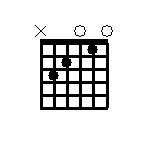On string instruments, a stopped note is a note whose pitch has been altered from the pitch of the open string by the player's left hand pressing (stopping) the string against the fingerboard.
Bowed strings

On bowed string instruments, a stopped note is a played note that is fingered with the left hand, i.e. not an open string. This assists with tone production, the addition of vibrato, and sometimes additional volume but creates difficulty in that bowed string instruments do not have frets, requiring ear training and accurate finger placement. The lack of frets, as on the guitar fretboard, does allow greater variability in intonation though a bowed string instrumentalist, such as a violinist, "when unaccompanied, does not play consistently in either the tempered or the natural scale, but tends on the whole to conform with the Pythagorean scale"


The open notes of the highest three strings may be played as stopped notes on the lowest three strings, offering advantages and disadvantages:
| Open | Stopped |
| Easy to play | More technically demanding |
| No vibrato available | Vibrato and multi-expression available |
| Essentially fixed pitch | Unlimited ability to adjust intonation |
| Notes are full and bright | Notes are slightly less resonant |
| Tone color may be brash, not blending well | Tone color is controllable, and may be more uniform |
| Pizzicato notes sustain longer | Notes are shorter when plucked |
| Easier to play two notes | Double-stops are harder, but blend better |
Fingered tremolos, the rapid alternation of two notes, are best between two stopped notes on one string, in which case it is limited to the interval of an augmented fourth, or between stopped notes on two adjacent strings:

Plucked strings

On plucked string instruments with frets, such as the guitar, the pitch of a stopped note is determined by the left hand pressing (stopping) the string at one of the frets.
Sources
- ^ Andrea Pejrolo, Rich DeRosa (2007). Acoustic and MIDI Orchestration for the Contemporary Composer, p.99-100. ISBN 0-240-52021-1.
- Seashore, Carl (1938). Psychology of Music, 224. quote in Kolinski, Mieczyslaw (Summer - Autumn, 1959). "A New Equidistant 12-Tone Temperament", p.210, Journal of the American Musicological Society, Vol. 12, No. 2/3, pp. 210-214.
- Cecil Forsyth (1982). Orchestration, p.356. ISBN 0-486-24383-4.
| Musical techniques | |
|---|---|
| General | |
| Wind instruments | |
| Piano | |
| Bowed string instruments | |
| Guitar | |
| Harp | |
| Percussion | |
| Human voice | |
| Related articles | |